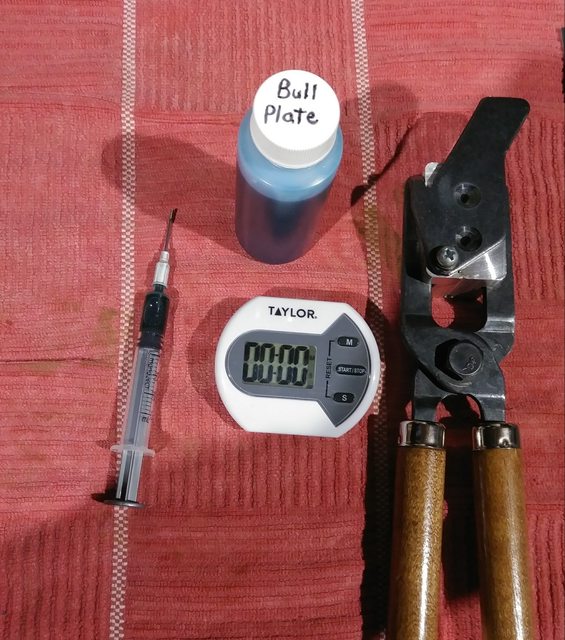Idaholewis
Well-Known Member
- Joined
- Jun 30, 2017
- Messages
- 7,287
- Reaction score
- 10,288
This is a MAJOR part of Casting HIGH Quality PURE Lead Bullets, in Fact it’s The most important Part i can Think of? Temperature of the PURE Lead is Very important as Well, These 2 Go Hand n Hand. I get my BEST Results with PURE Lead at 775-800 Degrees
With a Clean, Oil Free Mold. You have to Get the Mold HOT, and i mean REALLY HOT! (Remember, Aluminum molds heat up REALLY fast, Steel Molds take CONSIDERABLY longer to Heat up, Over Twice as long as Aluminum)
How i do this is quite Simple, I hold the Bottom of my Mold in the Molten Lead. My Goal is to Slightly Over Heat the Mold, When i make my 1st Cast the Sprue Puddle Can Take up to 1 minute to Solidify (Depending on Bullet Cavity Size), As quick as i see the Puddle FULLY Solidify (if it’s a Large Bullet, you will notice a Hole “sinking in” the Center of the Lead) Count a FULL 45 Seconds to 1 Minute here BEFORE Opening the Mold to Dump the Bullet out. If the Bullet has not Solidified it will make a Hell of MESS in your Mold, You end up losing what you Gained by having to Clean the Stuck Lead from the Mold Halves (If this Happens, use a Clean WOOD STICK like a Popsicle, or Paint Stick to Scrape the Lead out, Anything else Can/will Scratch Your Mold) Trust me when i Say To make Sure the Bullet has Fully Solidified before opening the Mold! Get yourself a Kitchen Timer, They are Cheap, and an invaluable little tool to the Serious Caster.
Using the Method i describe above (Dipping the Bottom of the Mold in the Molten Lead) Here are times i use, I am gonna list times i use for IRON/STEEL Molds, as i rarely Cast with Aluminum Molds (I DESPISE Aluminum Bullet Molds) I don’t Guess these times, I use a Kitchen Timer and get them Exact.
My Iron/Steel Lyman Molds Take about 4 Minutes to Slightly Over Heat
my Iron/Steel Accurate Molds take About 7-8 Minutes to Slightly Over Heat, CONSIDERABLY Longer Than my Lyman Molds, as they are MUCH Bigger and Heavier than a Lyman Mold.
Now that you have Slightly Over Heated your Mold, Swing the Sprue Plate WIDE OPEN and Fill the Cavity (As stated above, DO NOT Try and Dump this 1st Bullet out to Fast, give it a FULL 45 Seconds to 1 Minute AFTER You See the Sprue Puddle Finally Solidify) As quick as you are able to Safely Dump this 1st Bullet out, IMMEDIATELY Fill the Cavity again, This time it will Take Considerably Less time to Solidify, When you are Sure it has Solidified, Dump this Bullet as well, and IMMEDIATELY Fill the Cavity again. Do this for about 5-6 Cycles/Bullets, Now Swing the Sprue Plate Closed and Start Casting For Keeps

With a Clean, Oil Free Mold. You have to Get the Mold HOT, and i mean REALLY HOT! (Remember, Aluminum molds heat up REALLY fast, Steel Molds take CONSIDERABLY longer to Heat up, Over Twice as long as Aluminum)
How i do this is quite Simple, I hold the Bottom of my Mold in the Molten Lead. My Goal is to Slightly Over Heat the Mold, When i make my 1st Cast the Sprue Puddle Can Take up to 1 minute to Solidify (Depending on Bullet Cavity Size), As quick as i see the Puddle FULLY Solidify (if it’s a Large Bullet, you will notice a Hole “sinking in” the Center of the Lead) Count a FULL 45 Seconds to 1 Minute here BEFORE Opening the Mold to Dump the Bullet out. If the Bullet has not Solidified it will make a Hell of MESS in your Mold, You end up losing what you Gained by having to Clean the Stuck Lead from the Mold Halves (If this Happens, use a Clean WOOD STICK like a Popsicle, or Paint Stick to Scrape the Lead out, Anything else Can/will Scratch Your Mold) Trust me when i Say To make Sure the Bullet has Fully Solidified before opening the Mold! Get yourself a Kitchen Timer, They are Cheap, and an invaluable little tool to the Serious Caster.
Using the Method i describe above (Dipping the Bottom of the Mold in the Molten Lead) Here are times i use, I am gonna list times i use for IRON/STEEL Molds, as i rarely Cast with Aluminum Molds (I DESPISE Aluminum Bullet Molds) I don’t Guess these times, I use a Kitchen Timer and get them Exact.
My Iron/Steel Lyman Molds Take about 4 Minutes to Slightly Over Heat
my Iron/Steel Accurate Molds take About 7-8 Minutes to Slightly Over Heat, CONSIDERABLY Longer Than my Lyman Molds, as they are MUCH Bigger and Heavier than a Lyman Mold.
Now that you have Slightly Over Heated your Mold, Swing the Sprue Plate WIDE OPEN and Fill the Cavity (As stated above, DO NOT Try and Dump this 1st Bullet out to Fast, give it a FULL 45 Seconds to 1 Minute AFTER You See the Sprue Puddle Finally Solidify) As quick as you are able to Safely Dump this 1st Bullet out, IMMEDIATELY Fill the Cavity again, This time it will Take Considerably Less time to Solidify, When you are Sure it has Solidified, Dump this Bullet as well, and IMMEDIATELY Fill the Cavity again. Do this for about 5-6 Cycles/Bullets, Now Swing the Sprue Plate Closed and Start Casting For Keeps








